Now & New
- Experience
45th Annual Hiroshima Flower Festival: Harnessing the Power of Flowers
Hiroshima’s Flower Festival has quite a bit of history behind it; likewise, I have a bit of a history with this festival regarding my attitude towards it. When I first moved to this vibrant, peaceful city and attended the Flower Festival for the first time with new friends and acquaintances, I was highly enthused and eager to take part in the festivities in subsequent years. However, that was when I used to live in the suburbs, and after moving into the heart of the city my view of the festival took a 180-degree turn. The Flower Festival is always held on the 3rd, 4th, and 5th of May, which comprise the latter part of Golden Week. Most folks in this city choose one of the three days to visit the festival, but since the festival site was close to my residence, I could technically go there on all three days. In fact, my first year living downtown, I realized that I had no choice but to be a part of the festival. The loud music from the parade would wake me up in the morning on days I wanted to sleep in, and doing mundane things like going grocery shopping meant I had to wade through a sea of festivalgoers to get anywhere at all, and rainy days exacerbated that problem with the added “umbrella altitude adjustment mechanic” we all practice to avoid smacking people or getting smacked. It got to the point where I insisted on taking trips out of town—even considering nationwide congestion and soaring prices—just to escape the frustration that the Flower Festival brought me every Golden Week.
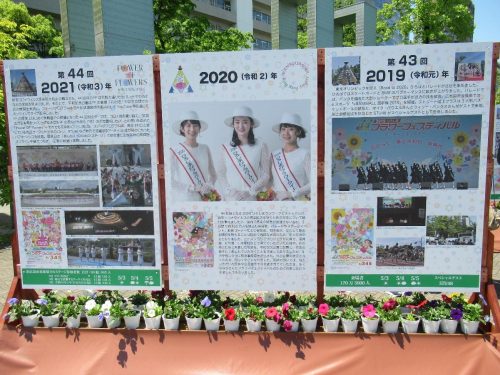
Naturally, in the cursed year of 2020, the Flower Festival was canceled and we all stayed at home to save each other’s lives from the novel coronavirus. Initially, I welcomed the quiet that accompanied the lack of a festival, and went about those days loafing around at home. We all thought the world would be back to normal in 2021, but as it was still too dangerous to hold an honest-to-goodness festival, the Flower Festival was held without spectators, and the on-stage performances were streamed online for wistful enthusiasts to view from the comfort of their couches and beds. Despite always trying to avoid the Flower Festival in recent years leading up to the pandemic, I was starting to miss it, so I decided that were it to be held (provided spectators were allowed), I would attend it on all three days just like I did many moons ago. Sure enough, the Flower Festival was underway in 2022, though greatly diminished in scale; there would be no parade or food stalls, and the performances would be restricted to three venues downtown: the Carnation Stage, the Rose Stage, and the Dahlia Stage. At first, I found it peculiar that the shows would be held indoors, but I suppose that helps the event organizers enforce social distancing and regulate the number of spectators at the venues at any given time.
May 3rd, Constitution Memorial Day
As there was no parade to give me a rude awakening on May 3rd, the first day of the festival, I set my alarm to wake up well before the opening ceremony at Peace Memorial Park. On my way there, I couldn’t help but notice how relatively empty Peace Boulevard was compared to how it was during festivals past, but breathed a sigh of relief when I saw the usual crowds gathered around the fountain south of the Peace Memorial Museum. I thought I was running late that day, but in reality, I couldn’t have timed it better as they were in the process of lighting the Flower Tower with the torch as soon as I arrived. This was the official signal to commence the three-day festival period, and with the announcement over the loudspeaker, folks got to celebrating!
There were plenty of flowery float props where visitors could have their photos taken to commemorate the first real festival in three years. Near one of said floats, a news agency was interviewing two of the three Flower Queens, some lucky, beautiful ladies who have the honor of representing the festival as a whole. I wasn’t able to get up close due to the barrier and crowd of other photographers, but the raised float provided a vantage point for a glimpse of the interview.
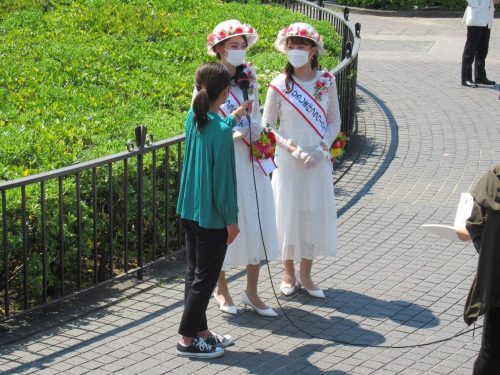
West of all of this lay a couple ramps and a staircase leading down to the basement of the Hiroshima International Center. It was through these doors that guests could enter the Carnation Stage, the largest of the three venues. As with the Port Festival in Kure, all spectators had to fill in an entry form to be granted access, but where the Flower Festival differs is that everyone scanned a QR code and filled out the form on their smartphones. After showing the confirmation screen to the staff, visitors are let into the hall and given two freebies: a foldable signboard and a pack of wet wipes for decontamination. Spectators were asked to not shout this year, so instead, we either waved our signboards at the performers or folded them up to clap loudly with them.

Originally, the idol group STU48 was supposed to kick off the day by gracing the opening ceremony with their presence, but because at least one of the members tested positive for COVID-19, that was canceled, as well as their actual performance the day after. The arena seats were only at half capacity for social distancing purposes, and after scanning row after row from the entrance, I found an empty chair for myself and slipped into it between musical numbers. As fate would have it, the first performing group of the day was a baton-twirling dance school, and when the same women in blue from Kure took the stage, my eyes lit up!
I would have loved to stick around to see the performances later in the day, but I had to rush to work after lunch so I called it a day for the time being. That afternoon would see spectacles such as a Mexican musical band sponsored by the Hiroshima Prefectural International Department, and even The Little Mermaid put on by the nationally acclaimed Shiki Theater Company. Unfortunately, I would be missing all of that, so I was determined to double my efforts to check out the state of the Flower Festival at night.
Springtime Dreamination
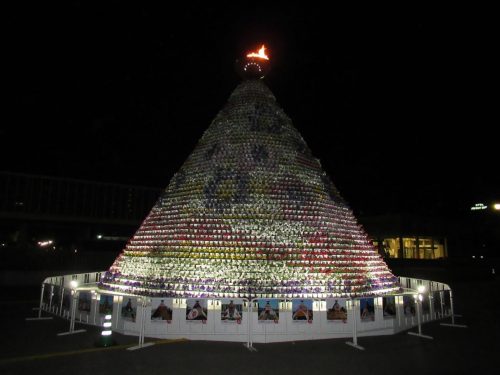
The celebrations don’t have to end when the performances do, for after the sun sets, Peace Boulevard takes on a new appearance that warrants a separate trip to see the décor after hours. The first thing to see is the Flower Tower, whose flame burns even more passionately in the dark and would remain ignited until the end of the festival’s final day. Dozens of passersby dropped by to marvel at the flickering fire at the top before carrying on, and virtually everybody wanted a picture of it. For the record, it took me a good number of attempts to capture the flame in a desirable shape like above.
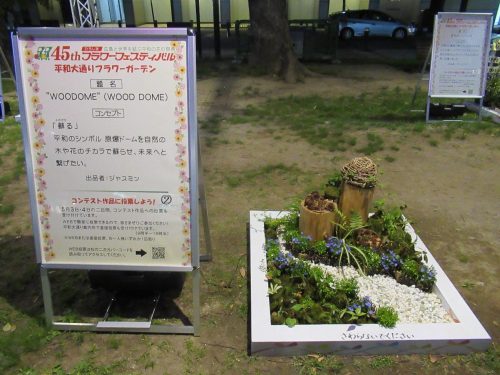
Continuing east of Peace Park, visitors come face to face with illuminated signs and potted plants inviting guests to have a look and take pictures after dark. One section of Peace Boulevard was dedicated to a “Flower Garden Contest,” in which contestants crafted an aesthetically pleasing and thought-provoking botanical display for viewers to vote on. Entry #2, titled “WOODOME,” was a replica of the Atomic Bomb Dome using wood and other vegetation, and was my personal favorite of the five entries. Further down the “Flower Road” was a faintly-lit path through the dirt that brought back memories of Dreamination, decorated on the side with flowers. Anyone who couldn’t make it to any of the festival sites during the day would be glad to know that this part of the festival on Peace Boulevard would remain for days after the shows ended.
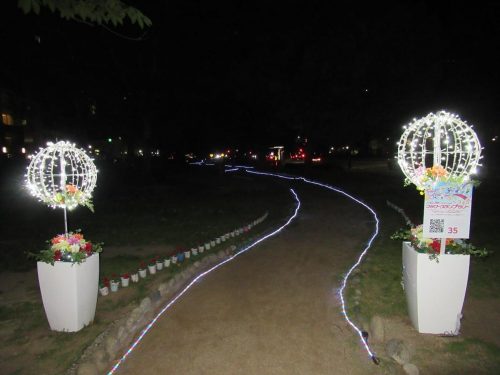
May 4th, Greenery Day
May 4th, known as Greenery Day in Japan and Star Wars Day everywhere else, was the day I was able to enjoy the Flower Festival with a friend. We met at the Flower Tower and proceeded down into the Carnation Stage to catch the first shows of the day. Although I was here the day before, I had to fill in a new entry form on my smartphone every day, and a different one for each venue I enter. Luckily, it was one form per group, so I was able to save my friend some trouble by registering on his behalf. It was more crowded than it was yesterday, so we were told to wait for a while longer before we were allowed into the arena. On the plus side, each day I went was another day to get more signboards and wet wipes!
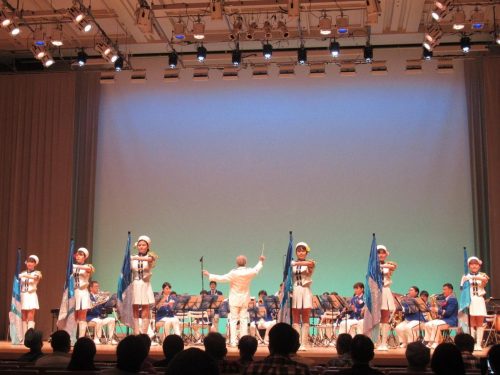
In the morning, there were marching bands from the Hiroshima Prefectural Police Department, the Hiroshima City Fire Department, and the Japan Ground Self-Defense Force each with their own time slots, playing a variety of amusing tunes. The Fire Department Musical Troupe even had a color guard waving flags in a regal fashion to the music, which I thought added a unique touch. After all three bands finished, we decided to head out to see what Peace Boulevard’s decorations looked like during the day.

Right across from the Flower Tower were several points of interest worthy of a commemorative photo, such as this wire paper crane-shaped palanquin. On the same section of the street were descriptive plaques detailing the history of the Hiroshima Flower Festival dating all the way to the first one in 1977. Those who have been to any of the Flower Festivals between then and now would feel like they were a part of this city’s history just by looking at the plaques, which in addition to pictures, also report on the estimated number of total attendees as well as the weather on each day of the festival every year.
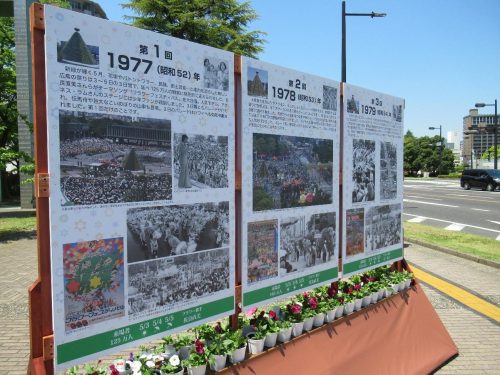
We then came to the part of Peace Boulevard where I was the previous night and I proceeded to take a bunch of photos of myself in wacky poses. As far as this year’s festival is concerned, this is probably the best perk of going to the Flower Festival with someone else as opposed to going alone. I had a hard time choosing which silly picture to feature here, but I went with the crane one because of the paper crane’s strong connection to Hiroshima’s history and culture.
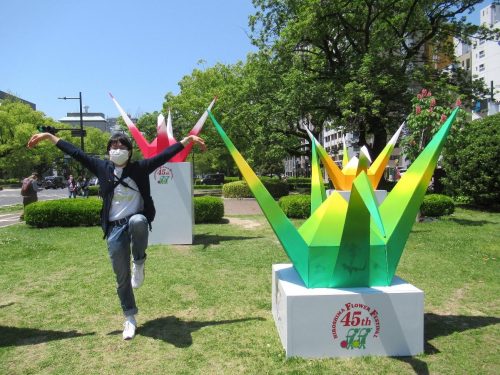
In the late afternoon, my friend and I parted ways, so I made my way back down to the Hiroshima International Center to watch some more shows. However, this time, instead of entering through the basement, I went in through the first floor to access the Rose Stage, which is located in the same building, but in a smaller arena (a separate virtual entry form is still required). I was right on time for dance numbers by the Noura✫Nori Belly Dance Company, which attracted more spectators than the groups that would perform after. I liked how this group featured women of all ages, and even one little girl, whom I speculate might be one of the members’ daughters.
Up next was a duo performing some calm, Brazilian-style samba music. I appreciate them properly wearing their masks the whole time, especially since the mask policy here wasn’t followed as strictly as it was during the smaller Kure Port Festival. This is the type of music that might put one to sleep, but this time of day was probably best suited to a moment of shut-eye.

The last group to perform on the Rose Stage for the day (and the rest of the festival as there would be no Rose Stage on May 5th) was a Hawaiian hula dance school. There were more little ones among them as well, with tropical outfits that vary by age group. In my opinion, the most impressive number was this one song put on by the older women, most likely instructors at the school. They used these peculiar, stick-like instruments to perform a rhythmic dance, tapping the instruments on various parts of their bodies and the floor to the music. It looks easy to imitate with something like a bundle of spaghetti, but don’t try that at home unless you want a bundle of shattered noodles on the floor.
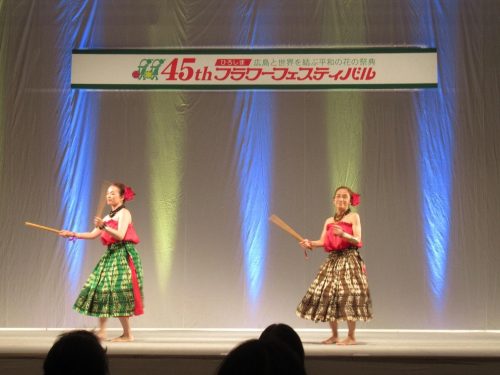
After the last show of the day ended, we dispersed out of the building and into Peace Park. It was close to sundown at this time, so I took a few minutes to appreciate the scenery at dusk. North of the Peace Memorial Museum was a space for people to light a candle and pray for peace. I imagine these pyramids and the surrounding décor would look even more marvelous when viewed from above inside the Peace Memorial Museum.
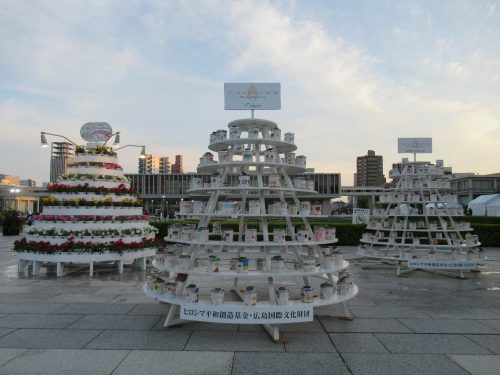
Moment of Joy: A Small World
Pandemic or no pandemic, Hiroshimarians have a tendency to assemble downtown during key events throughout the year like this one. That being said, despite Hiroshima being a sizeable city, I’m never surprised to bump into someone I know in situations such as these. When I was filling out the entry form for the Carnation Stage yet again on the last day of the festival, I found out the young lady who assisted me was a former student who recognized me and cared enough to chat me up. It felt good to be reminded how small this world is as I completed the form and was let into the arena to watch the taiko troupe play their hearts out.
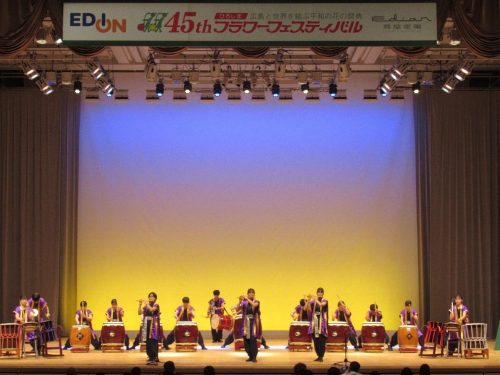
May 5th, Children’s Day
Just like back then, I could feel my energy levels dropping by the final day of the Flower Festival, but I was determined to see things through and explore as much of this limited festival as I could. I had a later start in the afternoon, which consisted of watching musicians playing the taiko, flutes, and miniature cymbals. After that, some soccer players from Sanfrecce Hiroshima (the men’s team) and Sanfrecce Hiroshima Regina (the women’s team) came on stage for an interview and lifting contest against some kids in the Sanfrecce soccer camp. It was certainly a sight to see, but since photography and videography were forbidden, you’ll just have to take my word for it. That was followed by the voting results of the Flower Garden Contest I saw two days ago; I had no doubt in my mind that “WOODOME” would be the winner, and it was! Since time was running short, I decided to call it there and make haste for the Dahlia Stage, the only venue I had yet to check out.

The Dahlia Stage was located farther away from the other festival sites on the eleventh floor of the Motomachi Cred Hall, right above the Pacela shopping mall. This was the time of day when yosakoi troupes took the stage, and while the performances were spectacular, they were more difficult to photograph and videotape. Yosakoi is a dance that’s typically performed outdoors, and with such large groups, these dancers probably needed more space than what the Dahlia Stage could provide. On the other hand, having the music play in a smaller space made the performances louder and more exhilarating, so that’s something to be thankful for. Most troupes opted for traditional-looking garb with face masks, but Fukubijin chose these unique overcoats reminiscent of the Golden Age of Piracy. In addition, the song they chose was about their hometown of Fukuyama, and given how the next major festival this month would be the Rose Festival in Fukuyama, this form of foreshadowing was much appreciated and a perfect way to end not only this day, but the Flower Festival as a whole.
The end of the Flower Festival typically signifies the end of Golden Week, but depending on one’s employer, the weekdays between the public holidays and the weekend may also be days off. I, however, had no such luck, so it was one day of work before being able to rest and head off on my next adventure. Even after the festival, the Golden Week feeling of festivity doesn’t disappear, as some events—especially sales and promotions at shopping centers—continue through the Sunday after.
Indeed, the Flower Festival in 2022 was something else, but in some aspects, it was more entertaining than it had been when I attended years prior. When performances are the only things available, I could concentrate my efforts there and see shows I normally wouldn’t have on account of all the festival stands on Peace Boulevard. With my new outlook on the Flower Festival, perhaps I could give it a chance again when it returns to normal by approaching it differently. After all, flowers and the message of peace they convey unite people the world over, making our society much like a spinning flower wreath. If I am inevitably part of this wreath in terms of location and relation to the city, I might as well party it up when I can and enjoy every moment of being a part of Hiroshima’s history.
Written by the Joy in Hiroshima Team
